大雁塔英文介绍---双语介绍
- 格式:doc
- 大小:30.50 KB
- 文档页数:10
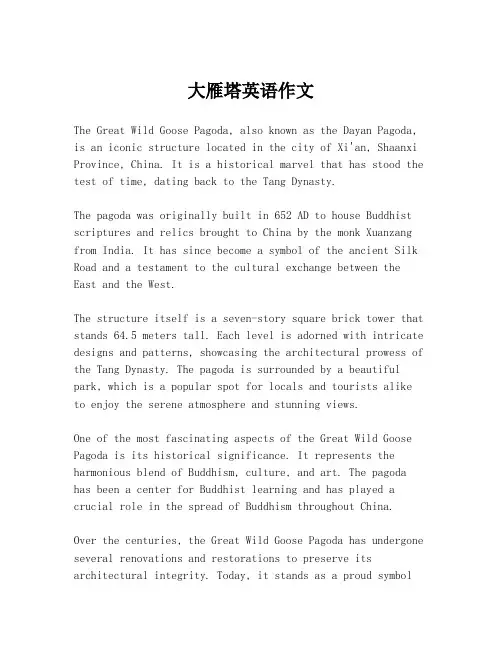
大雁塔英语作文The Great Wild Goose Pagoda, also known as the Dayan Pagoda, is an iconic structure located in the city of Xi'an, Shaanxi Province, China. It is a historical marvel that has stood the test of time, dating back to the Tang Dynasty.The pagoda was originally built in 652 AD to house Buddhist scriptures and relics brought to China by the monk Xuanzang from India. It has since become a symbol of the ancient Silk Road and a testament to the cultural exchange between the East and the West.The structure itself is a seven-story square brick tower that stands 64.5 meters tall. Each level is adorned with intricate designs and patterns, showcasing the architectural prowess of the Tang Dynasty. The pagoda is surrounded by a beautiful park, which is a popular spot for locals and tourists alike to enjoy the serene atmosphere and stunning views.One of the most fascinating aspects of the Great Wild Goose Pagoda is its historical significance. It represents the harmonious blend of Buddhism, culture, and art. The pagoda has been a center for Buddhist learning and has played a crucial role in the spread of Buddhism throughout China.Over the centuries, the Great Wild Goose Pagoda has undergone several renovations and restorations to preserve its architectural integrity. Today, it stands as a proud symbolof China's rich cultural heritage and a must-visitdestination for anyone interested in history and architecture.In conclusion, the Great Wild Goose Pagoda is not just a structure but a living piece of history that continues to inspire awe and admiration. Its significance goes beyond its physical presence, as it represents the cultural andspiritual journey of a nation. Visiting the pagoda is like stepping back in time and experiencing the rich tapestry of Chinese history and Buddhism.。
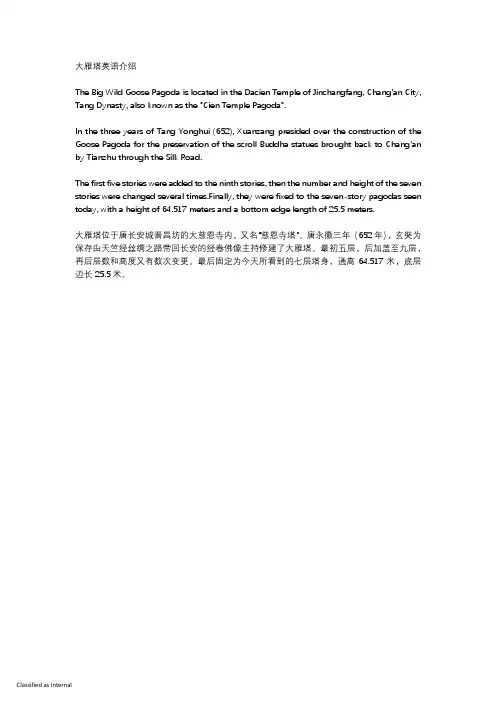
大雁塔英语介绍The Big Wild Goose Pagoda is located in the Dacien Temple of Jinchangfang, Chang'an City,Tang Dynasty, also known as the "Cien Temple Pagoda".In the three years of Tang Yonghui (652), Xuanzang presided over the construction of theGoose Pagoda for the preservation of the scroll Buddha statues brought back to Chang'anby Tianzhu through the Silk Road.The first five stories were added to the ninth stories, then the number and height of the sevenstories were changed several times.Finally, they were fixed to the seven-story pagodas seentoday, with a height of 64.517 meters and a bottom edge length of 25.5 meters.大雁塔位于唐长安城晋昌坊的大慈恩寺内,又名“慈恩寺塔”。
唐永徽三年(652年),玄奘为保存由天竺经丝绸之路带回长安的经卷佛像主持修建了大雁塔。
最初五层,后加盖至九层,再后层数和高度又有数次变更。
最后固定为今天所看到的七层塔身,通高64.517米,底层边长25.5米。
Classified as Internal。
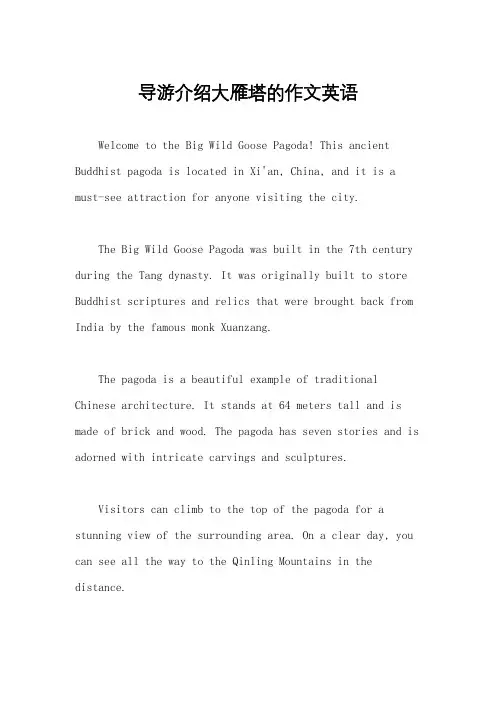
导游介绍大雁塔的作文英语Welcome to the Big Wild Goose Pagoda! This ancient Buddhist pagoda is located in Xi'an, China, and it is a must-see attraction for anyone visiting the city.The Big Wild Goose Pagoda was built in the 7th century during the Tang dynasty. It was originally built to store Buddhist scriptures and relics that were brought back from India by the famous monk Xuanzang.The pagoda is a beautiful example of traditional Chinese architecture. It stands at 64 meters tall and is made of brick and wood. The pagoda has seven stories and is adorned with intricate carvings and sculptures.Visitors can climb to the top of the pagoda for a stunning view of the surrounding area. On a clear day, you can see all the way to the Qinling Mountains in the distance.Surrounding the pagoda is the Da Ci'en Temple, a large complex with beautiful gardens and courtyards. The templeis a peaceful place to explore and learn about the historyof Buddhism in China.In addition to its historical and cultural significance, the Big Wild Goose Pagoda is also a popular spot for locals to gather and relax. You can often find people practicingtai chi or flying kites in the open areas around the pagoda.If you're interested in learning more about the history and significance of the Big Wild Goose Pagoda, there are regular cultural performances and exhibitions held at the site.Whether you're a history buff, a culture enthusiast, or just looking for a peaceful place to relax, the Big Wild Goose Pagoda has something to offer for everyone. So come and experience the beauty and tranquility of this ancient treasure!。
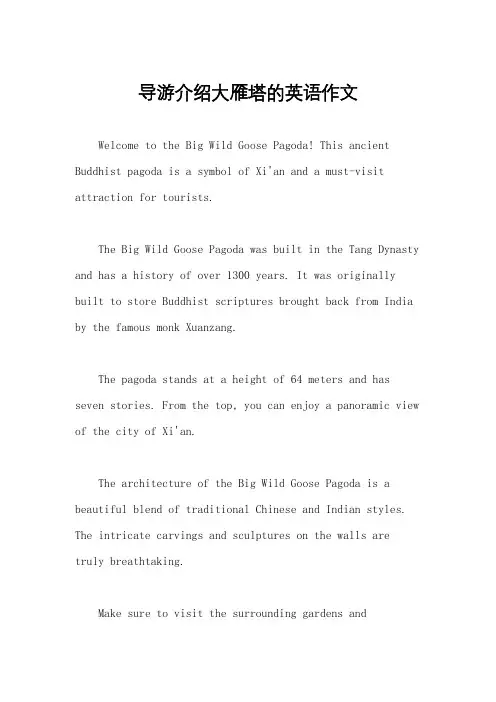
导游介绍大雁塔的英语作文Welcome to the Big Wild Goose Pagoda! This ancient Buddhist pagoda is a symbol of Xi'an and a must-visit attraction for tourists.The Big Wild Goose Pagoda was built in the Tang Dynasty and has a history of over 1300 years. It was originally built to store Buddhist scriptures brought back from India by the famous monk Xuanzang.The pagoda stands at a height of 64 meters and has seven stories. From the top, you can enjoy a panoramic view of the city of Xi'an.The architecture of the Big Wild Goose Pagoda is a beautiful blend of traditional Chinese and Indian styles. The intricate carvings and sculptures on the walls aretruly breathtaking.Make sure to visit the surrounding gardens andfountains, where you can relax and enjoy the peaceful atmosphere of this historic site.Don't forget to check out the nightly light and sound show at the Big Wild Goose Pagoda. It's a spectacular display that brings the pagoda to life in a whole new way.So come and explore the Big Wild Goose Pagoda, a place where history, culture, and spirituality come together in perfect harmony.。
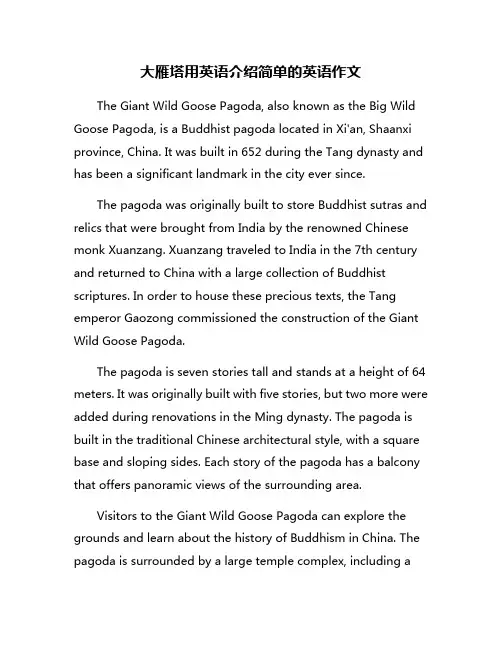
大雁塔用英语介绍简单的英语作文The Giant Wild Goose Pagoda, also known as the Big Wild Goose Pagoda, is a Buddhist pagoda located in Xi'an, Shaanxi province, China. It was built in 652 during the Tang dynasty and has been a significant landmark in the city ever since.The pagoda was originally built to store Buddhist sutras and relics that were brought from India by the renowned Chinese monk Xuanzang. Xuanzang traveled to India in the 7th century and returned to China with a large collection of Buddhist scriptures. In order to house these precious texts, the Tang emperor Gaozong commissioned the construction of the Giant Wild Goose Pagoda.The pagoda is seven stories tall and stands at a height of 64 meters. It was originally built with five stories, but two more were added during renovations in the Ming dynasty. The pagoda is built in the traditional Chinese architectural style, with a square base and sloping sides. Each story of the pagoda has a balcony that offers panoramic views of the surrounding area.Visitors to the Giant Wild Goose Pagoda can explore the grounds and learn about the history of Buddhism in China. The pagoda is surrounded by a large temple complex, including amuseum that displays artifacts from the Tang dynasty. There is also a large square in front of the pagoda where visitors can relax and enjoy the views.One of the most popular attractions at the Giant Wild Goose Pagoda is the nightly fountain show. The pagoda is illuminated with colorful lights, and water jets dance to music in a spectacular display. The fountain show attracts visitors from all over the world and is a must-see event for anyone visiting Xi'an.Overall, the Giant Wild Goose Pagoda is a must-visit destination for anyone interested in Chinese history and culture. Its impressive architecture, rich history, and stunning fountain show make it a unique and unforgettable experience. Whether you are a history buff or simply looking for a peaceful place to relax, the Giant Wild Goose Pagoda has something to offer everyone.。
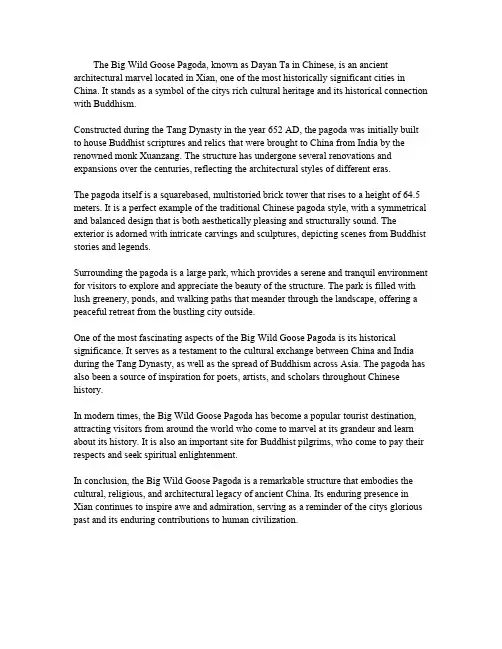
The Big Wild Goose Pagoda,known as Dayan Ta in Chinese,is an ancient architectural marvel located in Xian,one of the most historically significant cities in China.It stands as a symbol of the citys rich cultural heritage and its historical connection with Buddhism.Constructed during the Tang Dynasty in the year652AD,the pagoda was initially built to house Buddhist scriptures and relics that were brought to China from India by the renowned monk Xuanzang.The structure has undergone several renovations and expansions over the centuries,reflecting the architectural styles of different eras.The pagoda itself is a squarebased,multistoried brick tower that rises to a height of64.5 meters.It is a perfect example of the traditional Chinese pagoda style,with a symmetrical and balanced design that is both aesthetically pleasing and structurally sound.The exterior is adorned with intricate carvings and sculptures,depicting scenes from Buddhist stories and legends.Surrounding the pagoda is a large park,which provides a serene and tranquil environment for visitors to explore and appreciate the beauty of the structure.The park is filled with lush greenery,ponds,and walking paths that meander through the landscape,offering a peaceful retreat from the bustling city outside.One of the most fascinating aspects of the Big Wild Goose Pagoda is its historical significance.It serves as a testament to the cultural exchange between China and India during the Tang Dynasty,as well as the spread of Buddhism across Asia.The pagoda has also been a source of inspiration for poets,artists,and scholars throughout Chinese history.In modern times,the Big Wild Goose Pagoda has become a popular tourist destination, attracting visitors from around the world who come to marvel at its grandeur and learn about its history.It is also an important site for Buddhist pilgrims,who come to pay their respects and seek spiritual enlightenment.In conclusion,the Big Wild Goose Pagoda is a remarkable structure that embodies the cultural,religious,and architectural legacy of ancient China.Its enduring presence in Xian continues to inspire awe and admiration,serving as a reminder of the citys glorious past and its enduring contributions to human civilization.。
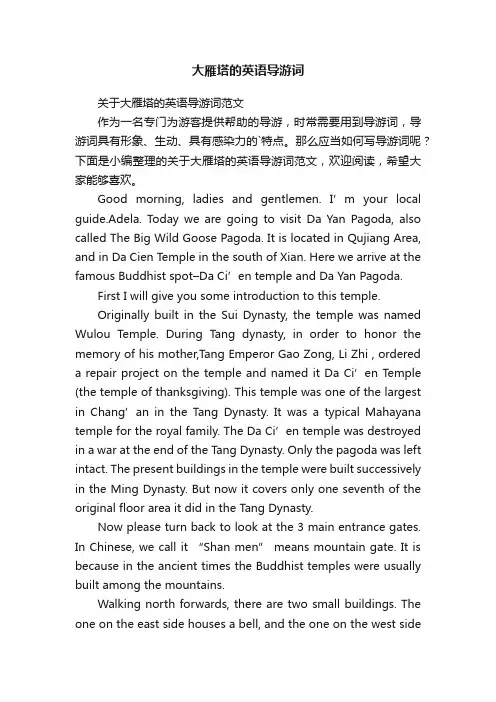
大雁塔的英语导游词关于大雁塔的英语导游词范文作为一名专门为游客提供帮助的导游,时常需要用到导游词,导游词具有形象、生动、具有感染力的`特点。
那么应当如何写导游词呢?下面是小编整理的关于大雁塔的英语导游词范文,欢迎阅读,希望大家能够喜欢。
Good morning, ladies and gentlemen. I’m your local guide.Adela. Today we are going to visit Da Yan Pagoda, also called The Big Wild Goose Pagoda. It is located in Qujiang Area, and in Da Cien Temple in the south of Xian. Here we arrive at the famous Buddhist spot–Da Ci’en temple and Da Yan Pagoda.First I will give you some introduction to this temple.Originally built in the Sui Dynasty, the temple was named Wulou Temple. During Tang dynasty, in order to honor the memory of his mother,Tang Emperor Gao Zong, Li Zhi , ordered a repair project on the temple and named it D a Ci’en Temple (the temple of thanksgiving). This temple was one of the largest in Chang’an in the Tang Dynasty. It was a typical Mahayana temple for the royal family. The Da Ci’en temple was destroyed in a war at the end of the Tang Dynasty. Only the pagoda was left intact. The present buildings in the temple were built successively in the Ming Dynasty. But now it covers only one seventh of the original floor area it did in the Tang Dynasty.Now please turn back to look at the 3 main entrance gates. In Chi nese, we call it “Shan men” means mountain gate. It is because in the ancient times the Buddhist temples were usually built among the mountains.Walking north forwards, there are two small buildings. The one on the east side houses a bell, and the one on the west sidehouses a drum. The bell and drum towers are two corresponding buildings. They are the typical landmarks of a temple. The drum and the bell were used to mark time for the monks in the temple. The bell is rung in the morning and the drum is struck at dusk. The Great Hall of Buddha is on the platform in the center of the temple in front of us. Inside the great Hall, there are three incarnations of Sakyamuni, who was the founder of Buddhism . The one in the middle is called Fashen Buddha, which means an embodiment [imb?dim?nt] of truth and law. The one on the west side is called Baoshen Buddha, which means a perfect Buddha after self-cultivation, and the one on the east side is called Yingshen Buddha, which means a changeable and guiding Buddha.Bef ore we move to the pagoda, let’s know something about a famous monk in Chinese history, Xuan Zang. He was both a great translator and traveler. He had spent 17 years in India to study Buddhism. And when he came back to Chang’an, he had taken back more than 600 volumes[v?lju:m] of Buddhist scriptures from India. He was indeed a great contributor the Buddhist cultural exchanges between India and china in ancient times.Now we come to the foot of the Da Yan Pagoda. Originally the pagoda was a five-story construction, 60 meters high. Because of the decay [dikei] of its rammed -earth and bricks, the pagoda increased to ten stories when it was under reconstruction in 704. However, the winds of war in the years to come brought the pagoda almost to ruins废墟, which in turn resulted in the construction of a seven-story structure with a height of 64 meters. This storied pagoda is an architectural marvel /wonder. It was built with layers of bricks but without any cement in between.The pagoda is characterized by its towering height, structural compactness, imposing appearance and unaffected style. It’s indeed a good reflection of people’s wisdom and talent in ancient China.There is also an interesting story about the name of the pagoda. According to ancient stories of Buddhists, there were two branches, for one of which eating meat was not a taboo. One day,they couldnt find meat to eat.Upon seeing a group of big wild goose flying by, a monk looked up at the sky and said , “Our beloved Buddha, the Great and Merciful , will give us some meat!” At that moment, the leading wild goose broke its wings and fell to the ground. All the monks were puzzled by this, and they believed that the Buddha showed his spirit to order them to be more pious. They also set up a pagoda where the wild goose fell and stopped eating meat. And called it the Wild Goose Pagoda.The Da Yan Pagoda that greets us today was actually modeled after its Indian style. It was given the same name in memory of Xuan zang and in praise of Buddhism. After about half a century, the pagoda at Jianfu Temple was built. The two pagodas face each other over a distance, and have different styles. Since the one in Jianfu Temple is smaller than the Wild Goose Pagoda, it is often called the Small Wild Goose Pagoda. Oppositely, this pagoda is called the Big Wild Goose Pagoda.Engraving autographs on the walls of the Da Yan Pagoda became the custom in the Mid-tang Dynasty. All the enrolled candidates [k?ndideit]考生who successfully passed the highest imperial examinations would first go boating on the Qu Jiang Lake and enjoy banquets in the Apricot Garden. Then they would visit the pagoda and carve their autographs on its walls. Thisforecast a successful career in the future. Now we can still climb the pagoda and enjoy the sight of the old capital.On the top you can have a bird’s view of Xi’an and also a view of the gardens around. To the north of the pagoda, there is the largest public square in Xi’an and also in China. Everyday we can see the largest music fountain playing there at a certain time.This music fountain is located in the Pagoda Square,which is one of the biggest squares in Asia.And it’s not only possesses the biggest music fountain in the world, but also surrounded by architectural imitations [imitei??n] of Tang Dynasty. It is 218 metres long from east to west, and 364 metres wide from south to north..It is not only provides citizens with leisure space, but also improves the environment and enhances the overall image of the city.Not far from the pagoda, we can see another beautiful garden that is the Tang Paradise. It is a cultural theme park in the Tang style of an original royal garden. And it is the largest scale of garden modeled on the Tang Style in China. And it also boasts many new records: the largest movie on water screen in the world, the first theme park of five senses sight, sound, taste, touch and smell, the biggest outdoor fragrance project in the world ad the biggest reproduction of the Tang royal garden complex in China. If you are interest in that, we can also have a visit this afternoon.Ok, everyone, so much for this today. We still have some free time. So next, you may look around and take some pictures. We’ll leave at 11o’clock, so please don’t be late. You know I will miss you. And I’ll stay here, if you have any question, please ask me. By the way, watch your step please! So next, it’s your turn. Enjoy yourself and thank you for listening.。
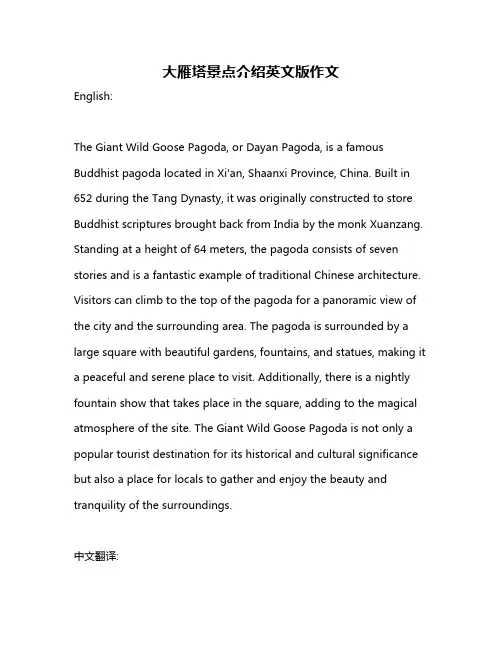
大雁塔景点介绍英文版作文English:The Giant Wild Goose Pagoda, or Dayan Pagoda, is a famous Buddhist pagoda located in Xi'an, Shaanxi Province, China. Built in 652 during the Tang Dynasty, it was originally constructed to store Buddhist scriptures brought back from India by the monk Xuanzang. Standing at a height of 64 meters, the pagoda consists of seven stories and is a fantastic example of traditional Chinese architecture. Visitors can climb to the top of the pagoda for a panoramic view of the city and the surrounding area. The pagoda is surrounded by a large square with beautiful gardens, fountains, and statues, making it a peaceful and serene place to visit. Additionally, there is a nightly fountain show that takes place in the square, adding to the magical atmosphere of the site. The Giant Wild Goose Pagoda is not only a popular tourist destination for its historical and cultural significance but also a place for locals to gather and enjoy the beauty and tranquility of the surroundings.中文翻译:大雁塔,又称大雁塔,是中国陕西省西安市著名的佛塔。
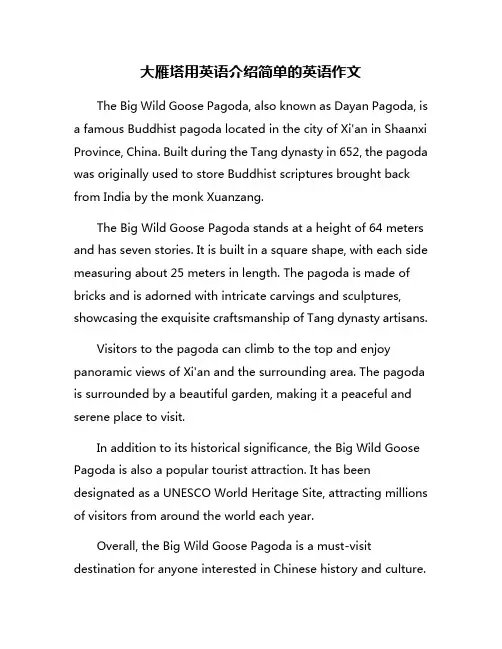
大雁塔用英语介绍简单的英语作文The Big Wild Goose Pagoda, also known as Dayan Pagoda, is a famous Buddhist pagoda located in the city of Xi'an in Shaanxi Province, China. Built during the Tang dynasty in 652, the pagoda was originally used to store Buddhist scriptures brought back from India by the monk Xuanzang.The Big Wild Goose Pagoda stands at a height of 64 meters and has seven stories. It is built in a square shape, with each side measuring about 25 meters in length. The pagoda is made of bricks and is adorned with intricate carvings and sculptures, showcasing the exquisite craftsmanship of Tang dynasty artisans.Visitors to the pagoda can climb to the top and enjoy panoramic views of Xi'an and the surrounding area. The pagoda is surrounded by a beautiful garden, making it a peaceful and serene place to visit.In addition to its historical significance, the Big Wild Goose Pagoda is also a popular tourist attraction. It has been designated as a UNESCO World Heritage Site, attracting millions of visitors from around the world each year.Overall, the Big Wild Goose Pagoda is a must-visit destination for anyone interested in Chinese history and culture.Its magnificent architecture and peaceful atmosphere make it a truly unforgettable experience.。
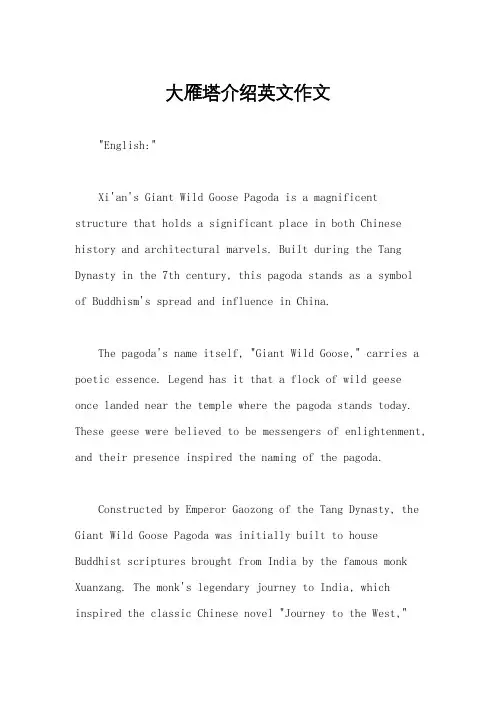
大雁塔介绍英文作文 "English:" Xi'an's Giant Wild Goose Pagoda is a magnificent structure that holds a significant place in both Chinese history and architectural marvels. Built during the Tang Dynasty in the 7th century, this pagoda stands as a symbol of Buddhism's spread and influence in China.
The pagoda's name itself, "Giant Wild Goose," carries a poetic essence. Legend has it that a flock of wild geese once landed near the temple where the pagoda stands today. These geese were believed to be messengers of enlightenment, and their presence inspired the naming of the pagoda.
Constructed by Emperor Gaozong of the Tang Dynasty, the Giant Wild Goose Pagoda was initially built to house Buddhist scriptures brought from India by the famous monk Xuanzang. The monk's legendary journey to India, which inspired the classic Chinese novel "Journey to the West," is commemorated by this towering structure. Standing at a height of over 64 meters, the pagoda has undergone several renovations and expansions throughout its history. Despite these changes, it retains its original grace and splendor, attracting millions of visitors from around the world every year.
![[大雁塔英文介绍]大雁塔英文](https://uimg.taocdn.com/003455fa951ea76e58fafab069dc5022aaea4681.webp)
[大雁塔英文介绍]大雁塔英文第一篇大雁塔英文:大雁塔英语导游词大雁塔英语导游词As the symbol of the old-line Xian, Big Wild Goose Pagoda is a well-preserved ancient building and a holy place for Buddhists. It is located in the southern suburb of Xian City, about 4 kilometers (2.49 miles) from the downtown of the city. Standing in the Da Ci"en Temple plex, it attracts numerous visitors for its fame in the Buddhist religion, its si-mp-le but appealing style of construction, and its new square in front of the temple. It is rated as a National Key Cultural Relic Preserve as well as an AAAA Tourist Attraction.This attraction can be divided into three parts: the Big Wild Goose Pagoda, the Da Ci"en Temple, and the North Square of Big Wild Goose Pagoda.Big Wild Goose PagodaOriginally built in 652 during the reign of Emperor Gaozong of the Tang Dynasty (618-907), it functioned to collect Buddhist materials that were taken from India by the hierarch Xuanzang.Xuanzang started off from Chang"an (the ancient Xian),along the Silk Road and through deserts, finally arriving in India, the cradle of Buddhism. Enduring 17 years and traversing 100 countries, he obtained Buddha figures, 657 kinds of sutras, and several Buddha relics. Having gotten the permission of Emperor Gaozong (628-683), Xuanzang, as the first abbot of Da Ci"en Temple, supervised the building of a pagoda inside it. With the support of royalty, he asked 50 hierarchs into the temple to translate Sanskrit in sutras into Chinese, totaling 1,335 volumes, which heralded a new era in the history of translation. Based on the journey to India, he also wrote a book entitled "Pilgrimage to the West" in the Tang Dynasty, to which scholars attached great importance.First built to a height of 60 meters (197 feet) with five stories, it is now 64.5 meters (211.6 feet) high with an additional two stories. It was said that after that addition came the saying-"Saving a life exceeds building a seven-storied pagoda". Externally it looks like a square cone, si-mp-le but grand and it is a masterpiece of Buddhist construction. Built of brick, its structure is very firm. Inside the pagoda, stairs twist up so that visitors can climb and overlook the panorama of Xian City from the arch-shaped doors on four sides of each storey. On the walls areengraved fine statues of Buddha by the renowned artist Yan Liben of the Tang Dynasty. Steles by noted calligraphers also grace the pagoda.As for the reason why it is called Big Wild Goose Pagoda, there is a legend. According to ancient stories of Buddhists, there were two branches, for one of which eating meat was not a taboo. One day, they couldn"t find meat to buy. Upon seeing a group of big wild geese flying by, a monk said to himself: "Today we have no meat. I hope the merciful Bodhisattva will give us some." At that very moment, the leading wild goose broke its wings and fell to the ground. All the monks were startled and believed that Bodhisattva showed his spirit to order them to be more pious. They established a pagoda where the wild goose fell and stopped eating meat. Hence it got the name "Big Wild Goose Pagoda".Da Ci"en TempleDa Ci"en Temple is the home of Big Wild Goose Pagoda. In 648, to memorate the dead virtuous queen, royalty ordered the building of a temple named "Ci"en" (Mercy and Kindness), for which the status and scale far exceeded all others. Today, with an area of 32,314 square meters (38,648.5 square yards), one seventh of the original area, it still retains its grandeur.Before the temple, there stands a statue of hierarch Xuanzang, the meritorious hierarch. Walking on and acroa small bridge, visitors will see the gates of the temple. With guarding lions, the temple seems stately for lions were said to function as talismans.Entering the temple you will see two buildings-Bell Tower in the east and Drum Tower in the west. Inside the Bell Tower hangs an iron bell 15 tons (14.76 grotons) in weight. It was molded in 1548 in the Ming Dynasty (1368-1644). Along the central axis are arranged the Hall of Mahavira, Sermon Hall, Big Wild Goose Pagoda, and the Hall of Xuanzang Sanzang. In the Hall of Mahavira are three carved statues of Sakyamuni, and 18 arhats as well as Xuanzang. The Sermon Hall is where Buddhist disciples would listen to a sermon. A bronze statue of Amitabha is dedicated and a Buddha statue is collected by Xuanzang as oblation. The Hall of Xuanzang Sanzang is north of Big Wild Goose Pagoda. In this hall are Xuanzang"s relic and a bronze statue of a seated Xuanzang. The inner wall is chiseled with murals depicting this hierarch"s story. Renowned as the contemporary Dunhuang Buddhist storehouse praised by UNESCO, it is the biggest memorial of Xuanzang.North Square of Big Wild Goose PagodaSurrounding Big Wild Goose Pagoda, the scenery is also quite charming, especially the square north of the Da Ci"en Temple. Covering about 110,000 square meters (__ square yards) plus 20,000 square meters (__.6 square yards) of water area, it holds many records: in Asia, it is the biggest Tang-culture square, the biggest fountain and waterscape square, and the largest-scale sculptures area. In the world, it has the most benches, the longest light-belt, and the largest-scale acoustic plex.The entire square is posed of waterscape fountains, a cultural square, gardens and tourist paths. There you can taste real Chinese culture and traditions and fully enjoy the truly attractive views. With reliefs on the theme of the prosperous Tang Dynasty, 200-meter-long (656-foot-long) sculpture groups, 8 groups of sculpted figures, 40 relievos on the land, and 22 styles of musical fountains, it has e a must-see when you visit Big Wild Goose Pagoda.拓展:大雁塔导游词不知道大家有没有听过“要看中国的五百年,请到北京;要看中国五千年,请到西安”,看到这就应该知道西安历史的悠久,西安曾是十三个朝代的首都,也是中国七大古都之一,更与雅典、开罗、罗马一起被誉为“世界四大文明古都”。
大雁塔英文介绍 As the symbol of the old-line Xian, Big Wild Goose Pagoda is a well-preserved ancient building and a holy place for Buddhists. It is located in the southern suburb of Xian City, about 4 kilometers (2.49 miles) from the downtown of the city. Standing in the Da Ci'en Temple complex, it attracts numerous visitors for its fame in the Buddhist religion, its simple but appealing style of construction, and its new square in front of the temple. It is rated as a National Key Cultural Relic Preserve as well as an AAAA Tourist Attraction.This attraction can be divided into three parts: the Big Wild Goose Pagoda, the Da Ci'en Temple, and the North Square of Big Wild Goose Pagoda.Big Wild Goose PagodaOriginally built in 652 during the reign of Emperor Gaozong of the Tang Dynasty (618-907), it functioned to collect Buddhist materials that were taken from India by the hierarch Xuanzang.Xuanzang started off from Chang'an (the ancient Xian), along the Silk Road and through deserts, finally arriving in India, the cradle of Buddhism. Enduring 17 years and traversing 100 countries, he obtained Buddha figures, 657 kinds of sutras, and several Buddha relics. Having gotten the permission of Emperor Gaozong (628-683), Xuanzang, as the first abbot of Da Ci'en Temple, supervised the building of a pagoda inside it. With the support of royalty, he asked 50 hierarchs into the temple to translate Sanskrit in sutras into Chinese, totaling 1,335 volumes, which heralded a new era in the history of translation. Based on the journey to India, he also wrote a book entitled 'Pilgrimage to the West' in the Tang Dynasty, to which scholars attached great importance.First built to a height of 60 meters (197 feet) with five stories, it is now 64.5 meters (211.6 feet) high with an additional two stories. It was said that after that addition came the saying-'Saving a life exceeds building a seven-storied pagoda'. Externally it looks like a square cone, simple but grand and it is a masterpiece of Buddhist construction. Built of brick, its structure is very firm. Inside the pagoda, stairs twist up so that visitors can climb and overlook the panorama of Xian City from the arch-shaped doors on four sides of each storey. On the walls are engraved fine statues of Buddha by the renowned artist Yan Liben of the Tang Dynasty. Steles by noted calligraphers also grace the pagoda.As for the reason why it is called Big Wild Goose Pagoda, there is a legend. According to ancient stories of Buddhists, there were two branches, for one of which eating meat was not a taboo. One day, they couldn't find meat to buy. Upon seeing a group of big wild geese flying by, a monk said to himself: 'Today we have no meat. I hope the merciful Bodhisattva will give us some.' At that very moment, the leading wild goose broke its wings and fell to the ground. All the monks were startled and believed that Bodhisattva showed his spirit to order them to be more pious. They established a pagoda where the wild goose fell and stopped eating meat. Hence it got the name 'Big Wild Goose Pagoda'.Da Ci'en TempleDa Ci'en Temple is the home of Big Wild Goose Pagoda. In 648, to commemorate the dead virtuous queen, royalty ordered the building of a temple named 'Ci'en' (Mercy and Kindness), for which the status and scale far exceeded all others. Today, with an area of 32,314 square meters (38,648.5 square yards), one seventh of the original area, it still retains its grandeur.Before the temple, there stands a statue of hierarch Xuanzang, the meritorious hierarch. Walking on and across a small bridge, visitors will see the gates of the temple. With guarding lions, the temple seems stately for lions were said to function as talismans.Entering the temple you will see two buildings-Bell Tower in the east and Drum Tower in the west. Inside the Bell Tower hangs an iron bell 15 tons (14.76 gross tons) in weight. It was molded in 1548 in the Ming Dynasty (1368-1644). Along the central axis are arranged the Hall of Mahavira, Sermon Hall, Big Wild Goose Pagoda, and the Hall of Xuanzang Sanzang. In the Hall of Mahavira are three carved statues of Sakyamuni, and 18 arhats as well as Xuanzang. The Sermon Hall is where Buddhist disciples would listen to a sermon. A bronze statue of Amitabha is dedicated and a Buddha statue is collected by